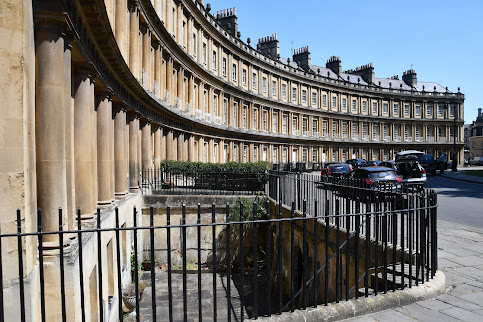I'm very happy to put my accutely optimised navagation skills away today.
I can rely on Dr Google to show us the way to drive to Bath via Glastonbury and Wells. Our guide in a book, Rick Steve, tells us it's worth stopping at these places to visit some....
... cathedrals. Well after yesterday's scary moments in the wilderness, it was great to have a car-driving day with cathedral interludes. I can look to the heavens and say thankyou!
Glastonburywas established around 712, and then there was a huge fire in 1184. It was rebuilt by the 14th century and became one of the richest monasteries in England. It is supposedly where King Arthur was buried in the sixth century.
There's a bit of conjecture about it, but in order to maintain the tourist income, when they were rebuilding it, the monks made out they found his remains. It certainly remains at least as the mythical burial ground for him.
The grave is in the open now because the actual Abbey is in ruins. It was a huge and rich Abbey until Henry VIII decided to become head of the church and ordered all the riches and the lead and the glass to be taken out of the abbey and sent to him.
And then after that, the place went into more ruin as locals raided the buildings for the bricks/rocks etc.
We then moved onto Wells. Now here's a cathedral Henry didn't raid:
These cathedrals are so big, I could get lost in them!
Here's Ruth thanking the Lord for helping us get here today WITHOUT INCIDENT!
After Weels, we drove to Bath. There's a cathedral there too.
Woohoo!
Day 1 in Bath we took a free guided walk with some 80 other freeloaders. Ruth and I found Bath a great place to visit. There is quite a lot of history here as well as great cultural activities.
Starting with the cathedral (I hope I'm not boring you) but they are special.
Some great buildings other than cathedrals here too. Here's an apartment block for instance:
We then went to the Bath Bathhouse.
I think this is why the place is called "Bath". What do you think?
Now this was very interesting too because it is a naturally occuring HOT spring. The Romans thought it was linked to their Gods somehow and so established this place as a thermal spa in the 1st century AD to communicate with them better.
This is how it works: The rain falls on the ground; It then seeps underground about 2 or 3 km down; The rocks down there press on the water, driving it back up; The water is under huge pressure and that heats it up; The water then rises up to the surface of the earth - in Bath.
The water that comes up out of the ground is at about 70 degrees Centigrade. Apparently it takes about 10,000 years for the rain drops to complete the cycle I described and end up in the Bathhouse!
Not sure the colour is all that attractive though:
You can see the water bubbling up if you look hard in that photo.
So the Romans loved this place, and from the first century on and over many years since, built a huge facility around where the hot water erupted out of the ground.
Here's a reconstruction of the ladies' section that I found very interesting:
Here's an outdoors section:
Later, we climbed up a hill on the outskirts of the city to get a view of the place and to get a feel of the size. The population is about 100,000 in Bath.
We took a foodie tour in Bath too while we were there. Now that was well worth it too.
We visited 8 different venues and covered lots of different food types. We enjoyed buns, smoothies, cheeses, teas, coffee, and more. I learned a lot actually.
The science of coffee manufacture was especially interesting for me. The absolute dedication to measuring the exact quantities, weights, temperatures, timing ticked my boxes. "You can't manage what you don't measure" was in action here:
Stomachs full and happy, next day was a day for some history. About an hour's drive away is Stonehenge:
This takes us back about 5,000 years!
We weren't alone marvelling at the history of this place.
On the way back to our accommodation in Bath, we stopped at Salsbury.
They had a cathedral there.
But the interesting thing about this for me is that this is where the Magna Carta was delivered in 1215.
Now that document is very special in human history - the foundations that mean "in a free world, all people have the right to justice". Before 1215, the King was above the law - but not after the Magna Carta was established.
The place had a quiet presence about it.
And it seemed to embrace "modern art" too:
I'm the first to admit I don't get a lot of art. Well this adds to my collection of art works I don't get!
But no probs... tomorrow, Ruth and I are going to return our hire car in London, then jump on a train to take us to Moreton-In-Marsh where we set out on an 8-day walk around the Cotswolds with a few friends, one of which is an artist. I'll let you know his take of the above piece.
Until then... be well.




















Comments
Post a Comment